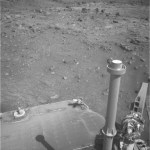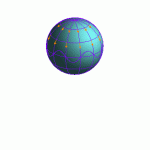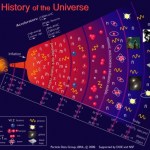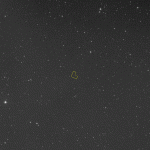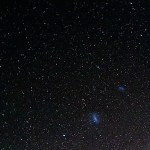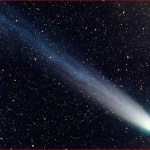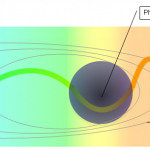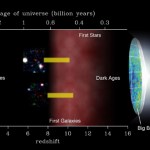
Recently, a discussion started in one of my comment threads about whether the Big Bang was necessarily valid or not, and whether there were any reasonable alternatives. The answer is that not only is the Big Bang the best theory to explain the start and evolution of the Universe, it's the only one that doesn't make incorrect predictions. Let's see this in action.
This all started in the late 1920s, when we realized that spiral nebulae were not just galaxies, but that these other galaxies were nearly all moving away from us. Moreover, the ones that were farther away from us were moving away…
Last year, while watching the Beijing Olympics, I was blown away by how much faster Usain Bolt was than everybody else:
He became the first man to run the 100 meter dash in under 9.7 seconds. Now, I thought, that's really, really fast. But then, just a few days ago, there was a race between the "World's Fastest Men", and Bolt said he would break his own record. The result?
9.58 seconds. An average speed of 23.4 miles per hour (37.6 kph). It isn't like humans can't run faster instantaneously, as Donovan Bailey, for an instant, has been clocked at 12.1 meters per second (27.1 mph / 43.6 kph…
This week's Carnival of Space introduced me to a new site, Habitation Intention. As always, the collection of space-related stories from around the 'net is worth checking out, and I've got my top three picks for you.
1. Goodbye, Moon and Mars! What, you thought that my opinion was shared by many? That we'd find a way to resume manned spaceflight to other worlds? That's we'd head to Mars after maybe stopping off at the Moon first? It isn't going to happen, says Cumbrian Sky. They've got the heartbreaking tale of death due to lack of funding, with some nice anger to go along with it.
2.…
About four months ago, the Mars Rover Opportunity was driving around Mars at about 50% power, as five years of accumulated Martian dust on its solar panels was disastrously affecting its ability to acquire power:
But a fortuitous, powerful gust of wind knocked much of the dust off, boosting Opportunity's power by about 40%. Because of this, Opportunity was able to continue making its way towards Endeavor crater -- the largest Martian crater that will ever be examined by any rover -- with an added power boost:
Well, a few weeks ago, Opportunity was cruising along the Meridiani Planum when it…
Sometimes, things happen that either:
I don't agree with,
I have different information than other people (sometimes more, sometimes less, sometimes just different), or
need to be spoken out against,
and that's when it's time to argue. Sometimes, there's no way around it, and I need to put myself out there, and make the best argument I can for one side of an issue based on what I know.
So this week, I have a conciliatory song from one of my favorite bands that you've probably never heard of, Storyhill, and this song is called Continents Collide. If I was near Dearwood, MN, I'd definitely…
Okay. Yesterday, I explained to you that the only thing that determines how the Universe expands is the amount of energy density in it. But many of you wanted more details. So, by popular demand -- including one insistence that there is no equation that tells us how the Universe expands -- here is the simplest explanation with math that I can come up with for the expanding Universe. If you hate or don't care about math, do not read this. This article is not for you. But if you're curious, read on.
Image credit: Wayne Hu.
First, let me tell you the underlying assumption behind all of it. You…
So, the Universe started with a bang. Everything was hot, dense, and expanding.
It's 13.7 billion years later now, and our Universe is cold and sparse. The temperature of the leftover glow from the big bang -- which used to be over 10^30 degrees -- is now down to 2.7 Kelvin, just barely above absolute zero. The Universe used to be denser than the center of the Sun. Now, on average, the density of the Universe is only about one proton per cubic meter, with mass clumped into stars and galaxies separated by trillions of miles.
But, for all of it, the Universe is still expanding. What's amazing…
It wasn't all that long ago that I wrote a five-part series on Hubble's old camera, WFPC2. I call it "The Camera that Changed the Universe." Part 1 focused on Hubble showing us just how deep, rich, and full of wonder our Universe is. Let's remember how this happened.
The first thing we did was take a patch of sky that was relatively empty. No bright stars, no large galaxies or clusters, no planetary nebulae, just a little tiny patch of black, empty sky.
And then we point Hubble at it. And what do we do? We sit there. And wait. Collecting tiny, miniscule amounts of light. First, for minutes…
When you go outside at night, on a clear night away from all lights, you see the sky the same way the ancients did: full of stars.
Now, if you looked up periodically, you would find that the sky appears to rotate! Some constellations rise while others set, and one point -- either due north or due south depending on your hemisphere -- appears to not move at all. With the advent of time-lapse photography (and go here for a fantastic video), we can see that the sky does something like this:
So there's some pretty good evidence, right away, that either the Earth is rotating or the entire sky is…
This week's Carnival of Space comes from New Frontier News, which has the oddest banner I've seen on a serious science website in a while:
The top three entries this week? As chosen, fairly arbitrarily, by me?
1. Pluto: planet or not? Apparently, the IAU got together again, for the first serious meeting since declassifying Pluto as a planet back in 2006. What happened? They didn't even talk about it. Alan Boyle has the story.
2. Iceteroids! What do you call a half-comet, half-asteroid? Mang at Mang's Bat Page talks about these newly discovered objects, called Main Belt Comets (MBCs).
3.…
There's a good reason for it, I promise! Allow me to explain. You see, every so often, a comet zooms in from the Kuiper Belt. As it approaches the Sun, it heats up, displaying a spectacular tail.
What is this "tail" actually? It's tiny, tiny fragments of ice and rock that make up the comet. You see, comets are like miniature, frozen planets. The gravity holding a comet together is amazingly weak because they're so tiny. For comparison, a grain of sand on the surface of a comet experiences less than 0.002% of gravity on Earth. This gravity is so small that tiny, micron-sized pieces of dust,…
When I issued my Charity Challenge to you a few weeks ago, I had no right to expect the support that all of you have given me. So listen to Michael Chapman singing Memphis in Winter while I give you what you gave for:
We have reached:
101 separate donations,
at least $3,260 in new donations pledged,
over 80 additional charity hours, and
many great additional donations, such as food, clothing, shoes, diapers, medicine, and many other philanthropic offers!
And so, as promised, you're getting what you paid for. Here's how I do it (and with all images, just click for the full size):
Step 1:…
Every once in awhile, a question makes it to my inbox that's too good to ignore.
A friend and I were joking about being "older than dirt" and he asked a question I thought you might enjoy: "Hey, ask Ethan how old dirt is and how it got here."
You did the smart thing by coming to me, because the alternative is to ask yahoo. (Shudder!) Well, right away, we've got an upper limit, because the entire Solar System is only about 4.5 billion years old. So, there's no way that this:
is any older than this:
Now, you can definitely go looking for the oldest rocks on Earth, and if you look very hard,…
The Wall Street Journal has just reported that over 1,000 people in the Americas, according to data released by the World Health Organization, have died from the Swine Flu. They seem to think you should be alarmed.
The global A/H1N1 swine flu pandemic has claimed 1,154 lives since the outbreak was identified in April, data published by the World Health Organization showed Wednesday.
The Geneva-based health agency also said that the number of laboratory-confirmed cases stood at 162,380 worldwide as of July 31.
The WHO has estimated that 2 billion people, or one in three of the world's…
Last week, we began talking about understanding the size of the Universe, and we continued this week with some information on distances and motion in the Universe. This brings us to my favorite application, which leads to the Hubble expansion:
Redshift. You see, whenever an atom or molecule emits light, it gives off that light at a very few particular wavelengths. For instance, if you have hydrogen, you'll always get light at wavelengths of 656 nanometers (red), 486 nm (cyan), 434 nm (indigo), 410 nm (violet), and 397 nm (on the border of violet/ultraviolet):
Now there are three things --…
Those of you who've been reading this site regularly know that we've been very busy of late, finishing our series on the last 100 years, working on raising money for charity, and discussing the deep issues of distances and motion in cosmology. But there is a whole lot of other space news buzzing around the internet, and each week, it gets wrapped up in a giant Carnival of Space.
The 114th edition is up at Cheap Astronomy, and my top three picks this week are as follows:
1.) Why aren't we Going to Mars? Cumbrian Sky takes a good look at Mars, and expressed sadness and frustration at how our…
At the end of last week, I wrote a post explaining how the Universe is so big (93 billion light years across) when it's only 13.7 billion years old. The key visualization is to think of space as being the surface of an expanding balloon, while all the things in the Universe (stars, galaxies, etc.) are like ants on that surface.
Now, I explained to you that two ants will appear to move apart from one another due to the expansion of the Universe, even though neither ant is moving relative to the surface of the balloon. If I use light to measure whether this other ant is moving away from me, I…
I am altering the deal. Pray I don't alter it any further.
Ahh... good old Star Wars. So, I am altering the deal. Two weeks ago, I told you all that we were having a charity challenge, and that if I got 100 of you to donate either money ($10 minimum) or time (4 hours minimum), I would shave my head for the first time ever. I even found a picture of me at 19, nearly 12 years ago, to help inspire you as to what a big step this was.
And we've come close as of today. We're only a few (less than 20) donations away, and I've been extraordinarily impressed with the outpouring of support I've…
I get a certain question every so often, and it's one of the most difficult questions any cosmologist faces. Today, I try to tackle it. It goes something like this:
If the Universe is 13.7 billion years old, and nothing can go faster than the speed of light, how is it that we see things that are 46.5 billion light years away?
First off -- and I want to clarify this -- everything in this question is legit.
1.) The Universe is 13.7 billion years old. There are small errors there -- no one would be surprised if it was 13.5 billion or 14.0 billion years old -- but it's definitely not 12 billion…
Sure, sure, everyone knows that stars twinkle. You look up at the night sky, and pretty much any star you look at appears to fluctuate in its brightness and intensity very rapidly, giving it a "twinkling" appearance.
Why does this happen? It definitely doesn't have anything to do with the star itself, because "our" star, which you call the Sun, definitely doesn't twinkle the same way:
Not only that, but there are a few objects in the night sky that don't twinkle: the Moon, planets, and satellites.
Why is that? Why do stars twinkle, and nothing else? Well, there were two theories.
One was…



